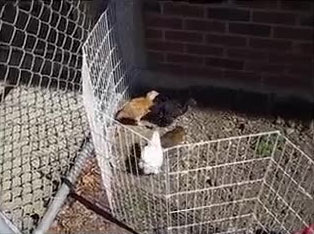About this video
This video shows preschool children engaged in mathematical thinking and in complex use of language as they watch chickens in a pen on their school playground.
The chickens hatched from eggs in the kindergarten/first-grade classroom’s incubator at a small school in Illinois. The children in the school’s prekindergarten classroom were also given a number of opportunities to become familiar with the chicks as they grew indoors.
This is the first time the teachers have put the chickens, which are now half-grown, outdoors to scratch and forage. They have not told the children about the chickens being outdoors, but within a few minutes, some of the children noticed them.
The first section of the clip shows several preschoolers who have gathered spontaneously at the pen to observe and talk about the chickens, which they have not seen for several weeks. When an adult visitor asks how many there are, a disagreement arises. Catherine says, “4.” Reggie says, “No” and then counts the chickens, pointing at each one as he says the number. When he finds that there are in fact 4, Catherine says vehemently, “I said 4!”
The visitor then asks how the chicks got where they are. Several children answer at the same time. For some, the response includes pointing to the window of the K-1 classroom. For others, such as Serena, the reply is almost entirely verbal. Serena’s explanation reveals her awareness of both sequence and location; she starts by talking about the farm (the source of the eggs), then mentions the K-1 class, and ends the sequence by saying that the chickens are now “in this little pen.”
In the second part of the clip, some children comment on the size of the chickens. Reggie, Kyle, and Len respond to one another’s ideas in a brief conversation during which they make predictions about the chickens’ future growth. Serena wonders aloud about why there seem to be fewer chickens now than when she last saw them.
This video clip illustrates some ways that early learning benchmarks may be met without direct instruction when teachers create an environment that encourages children to observe and investigate things around them. In their spontaneous conversations about the chickens, these preschoolers have used counting, made comparisons, made predictions, answered questions, and responded to (and sometimes challenged) their peers’ ideas.
Video
Transcript
Part 1
Visitor: So how many of them are there?
Reggie: Uh, 1—
Catherine: There’s 4!
Reggie: No, there’s 1, 2, 3, 4 (points as he counts).
Catherine: I, I said 4!
Visitor: I’m wondering where they came from. Did you guys have them in your classroom?
Serena: No—
Len: They were in the K-1 class.
Serena: No, they came, they came from a person in the K-1 class’s farm—
Visitor: Oh, the person had a, okay—
Kyle: Whoa, look at them stand on the other one! (Points at chickens.)
Serena: —and they were raising them in the K-1 class, and now they’re outside in this little pen.
Visitor: Oh, okay.
Part 2
Alphonso: And one there—
Len: They’re so big!
Reggie: They’re not SO big.
Serena: I wonder why there’s only like 3 left.
Kyle: Yeah, they’re gonna be like this big when they’re growed up.
Alphonso: They gonna be like THIS big.
Reggie: And they’re gonna be a mommy or a daddy.
Kyle: Yeah. (Reggie says something else to Kyle, but his words are unintelligible.)
Serena: I won—, I wonder why, I wonder why there’s not so much of them left.
Visitor: How many were there to start with, do you know? (Pauses.) Were there more than 4 to start with?
Serena: (Nods.) Yes, I think so.
Benchmarks and How They Were Met
| Benchmarks | How They Were Met |
|---|---|
| Language Arts 1.B.ECc: Continue a conversation through two or more exchanges. | Alphonso, Reggie, and Kyle had several exchanges during a conversation about the current and future size of the chickens. Serena’s conversations with the visitor featured multiple exchanges. |
| Language Arts 1.D.ECa: With teacher assistance, use complete sentences in speaking with peers and adults in individual and group situations. | During informal conversation with peers and an adult, all children used complete sentences in their comments and their responses to the visitor’s questions. |
| Language Arts 1.E.ECe: With teacher assistance, use adjectives to describe people, places, and things. | Serena used the adjective “little.” Len, Reggie, Kyle, and Alphonso used the adjective “big.” |
| Mathematics 6.A.ECa: Count with understanding and recognize “how many” in small sets up to 5. | Reggie and Catherine initially disagreed about the number of chickens; he counted them aloud, pointing to each one, and asserted, “There’s four.” |
| Mathematics 6.D.ECb: Describe comparisons with appropriate vocabulary, such as “more”, “less”, “greater than”, “fewer”, “equal to”, or “same as”. | The boys used the words “big” and “so big” to compare sizes of the chickens. Serena mentally compared the number of chicks in the pen with the number she saw previously (“There’s not so much of them left.”) |
| Science 12.A.ECb: Show an awareness of changes that occur in oneself and the environment. | Reggie, Len, Kyle, and Alfonso speculated what the chickens might be like as they grow. |
| Social Studies 16.A.ECa: Recall information about the immediate past. | Len and Serena told the visitor where the chicks were prior to being in the pen. |


